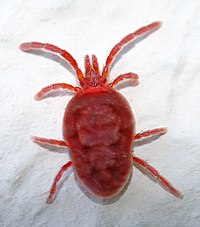
Photo from wikipedia
The use of genetically modified varieties tolerant to herbicides (HT varieties) and resistant to insects (Bt varieties) in combination with application of a broad‐spectrum herbicide such as glyphosate could be… Click to show full abstract
The use of genetically modified varieties tolerant to herbicides (HT varieties) and resistant to insects (Bt varieties) in combination with application of a broad‐spectrum herbicide such as glyphosate could be an effective option for the simultaneous control of weeds and pests in maize. Nevertheless, the possible impact of these tools on nontarget arthropods still needs to be evaluated. In a field study in central Spain, potential changes in populations of canopy‐dwelling arthropods in Bt maize under different weed management options, including glyphosate application, were investigated. Canopy‐dwelling arthropods were sampled by visual inspection and yellow sticky traps. The Bt variety had no effect on any group of studied arthropods, except for the expected case of corn borers—the target pests of Bt maize. Regarding the effects of herbicide regimes, the only observed difference was a lower abundance of Cicadellidae and Mymaridae on yellow sticky traps in plots not treated with pre‐emergence herbicides. This effect was especially pronounced in a treatment involving two glyphosate applications. The decrease in Cicadellidae and Mymaridae populations was associated with a higher density of weeds in plots, which may have hindered colonization of the crop by leafhoppers. These differences, however, were only significant in the last year of the study. The low likelihood of the use of glyphosate‐ and herbicide‐tolerant varieties for weed control triggering important effects on the nontarget arthropod fauna of the maize canopy is discussed.
Journal Title: Insect Science
Year Published: 2020
Link to full text (if available)
Share on Social Media: Sign Up to like & get
recommendations!